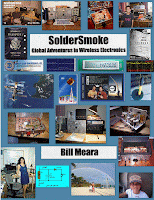Bill:
I think I’ve
finally earned the right to contact you. I have a really severe case of
the knack. I did not realize it until I discovered amateur radio.
My thinking is that there is no hope for those afflicted with the knack.
I believe that amateur radio helps those afflicted to deal with the
condition. It alleviates the symptoms.
For years I wandered
through the technical wilderness dabbling in physics (I have a M.Sc. in Nuclear
Physics), aircraft (I was a tow pilot at a gliding club for several years),
high power rockets (www.napas.net), electronics and amateur radio. The
most enjoyable part of radio is not the QSOs it’s the building and the
satisfaction of a working device.
I am relatively new to
amateur radio but I’ve always had a passion for all things electronic (and
technical). I am a self-taught electronics geek and have been playing
around with digital electronics (PIC microcontroller) for some time know. I
starting building altimeters for high power rockets that has the capability of
setting off onboard charges to separate the rocket. When your
rocket reaches 10,000 feet, you cannot open a chute at apogee because it’s
going to drift too far and you need to open the rocket at apogee (no chute) and
then open the main chute at about 1000 feet to minimize drift. I routinely
travel to the US to attend LDRS (large dangerous rocket ships).
Anyway I had to get my
amateur ticket for onboard video camera and trackers (beacons). Once I got
my license and got into radio, it was like a drug!!
I am now home
brewing everything in my shack.
When I came across
Soldersmoke that was like a super drug. I downloaded and listened to
EVERY episode (seriously!). I followed you and Mike’s journey and I
learned soooo much. I was devastated when I found out about Mike.
You inspired me to build
my own transmitter. Earlier this year I built a 20m CW transmitter for my
rocket that will eventually send telemetry (in CW from a PIC microcontroller)
completely from scratch – no kits – no one’s design. Your early episodes also
pushed me to learn LTSpice which I used extensively to model transmitter design
of others as well as my own. I’m thinking of calling the transmitter
“kaputnik”.
My design is based on a
Chinese AD9850 DDS module which generates a square wave followed by a class E
amp (with a tuned circuit). Puts out 1 watt of power with harmonics down
by about 40db. The reason I used this module with that I can easily
change frequency (with mod to tuned circuit) – after all the DDS module
is programmable. All I need to do now is clean up key clicks because the
carrier is turning on too fast. I playing around with slowly increasing
the bias on the mosfet to allow the power output to increase slowly. Any
advice/tips/tricks would be appreciated.
Next project is a remote
antenna switch. However, you have me close to tackling a SSB
transceiver.
Anyway, keep up the
great work and I’m looking forward to listening to another 150 episodes!!
Take care and “stay
thirsty” my friend.
73
Dave
Rajnauth, VE3OOI
Our book: "SolderSmoke -- Global Adventures in Wireless Electronics"
http://soldersmoke.com/book.htm
Our coffee mugs, T-Shirts, bumper stickers:
http://www.cafepress.com/SolderSmoke
Our Book Store:
http://astore.amazon.com/contracross-20






